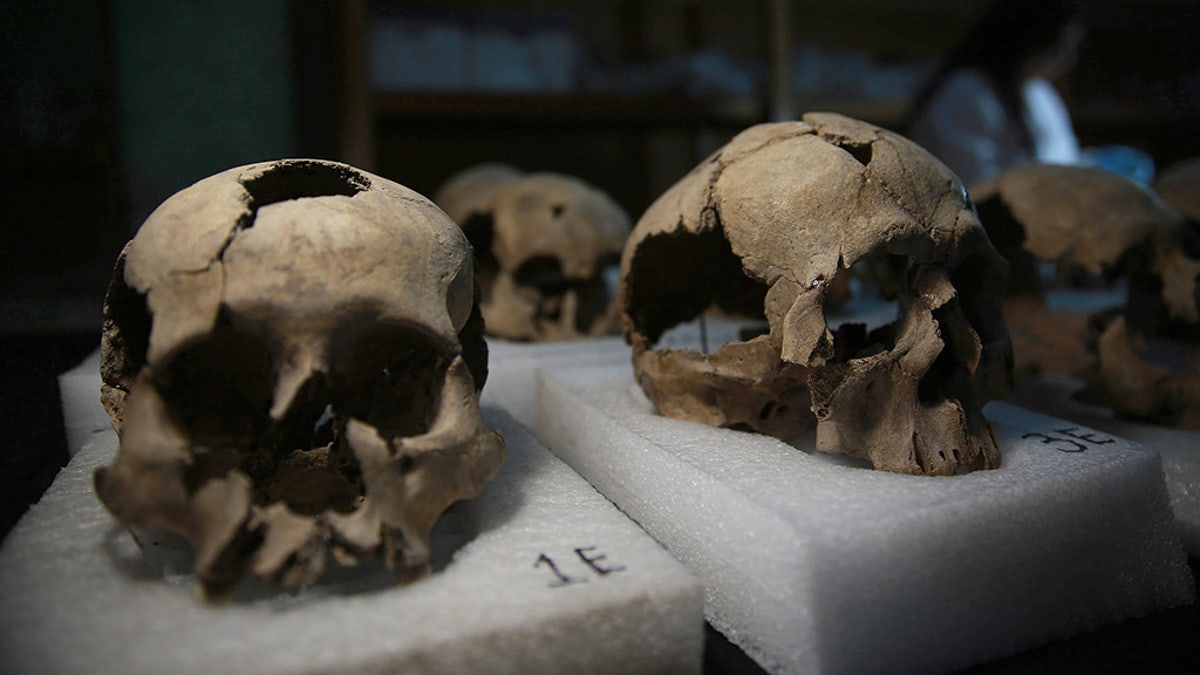
MEXICO CITY, MEXICO - JULY 10: Skulls, which were found during an excavation work, are seen in National Institute of Anthropology and History's laboratory in Mexico City, Mexico on July 10, 2017. More than 650 skulls and thousands of fragments were found near Templo Mayor, one of the main temples in the Aztec capital Tenochtitlan, which later became Mexico City. The discovery has raised new questions about the culture of sacrifice in the Aztec Empire. (Photo by Daniel Cardenas/Anadolu Agency/Getty Images) (2017 Anadolu Agency)
A vast array of skulls buried beneath the streets of modern Mexico City are revealing the grisly details of Aztec human sacrifice.
The area was once the epicenter of the Aztec city of Tenochtitlan - a gruesome site where human sacrifices were performed to honor the gods. Captives were taken to the city’s Templo Mayor, or great temple, where priests removed their still-beating hearts, Science reports.
The bodies were then decapitated and priests removed the skin and muscle from the corpses’ heads. Large holes were then carved into the sides of the skulls and placed onto a large wooden pole prior to being placed in the tzompantli, a huge rack of skulls in the front of the temple. Two towers of mortared skulls flanked the rack.
ARCHAEOLOGISTS DISCOVER AZTEC BALL COURT IN THE HEART OF MEXICO CITY
Paintings and written descriptions from the early colonial period document the macabre scene.

In this May 30, 2015 photo released by Mexico's National Institute of Anthropology and History (INAH), skulls are partially unearthed at the Templo Mayor Aztec ruin site in Mexico City. (Hector Montano/INAH via AP)
In 2015 archaeologists from Mexico’s National Institute of Anthropology and History (INAH) found the main trophy rack area and one of the skull towers at the Templo Mayor. More than 650 skulls and thousands of fragments were discovered, offering a glimpse into the Aztecs’ bloody culture.
Experts are now analyzing the discovery in detail. Science reports that, given the scale of the racks and the skull towers, archaeologists now estimate that several thousand skulls were likely displayed at a time.
MYSTERIOUS LOST MAYA CITIES DISCOVERED IN GUATEMALAN JUNGLE
In two seasons of excavations, archaeologists collected 180 mostly complete skulls from the tower and thousands of skull fragments. Cut marks confirm that they were “defleshed” after death and the decapitation marks are “clean and uniform.”
Three quarters of the skulls analyzed belonged to men, mostly aged between 20 and 35. Some 20 percent belonged to women and the remaining 5 percent were children. The victims are said to have been in “relatively good health” before they were sacrificed.
This corresponds with the analysis of victims sacrificed in “smaller offerings” in the Templo Mayor complex. By studying isotopes in the teeth and bones, experts have discovered that the victims were born in different places across Mesoamerica, but had often spent significant time in Tenochtitlan before their violent deaths.
EXPERTS DISCOVER TOMB OF MAYA 'GOD-KING'
Isotopic and DNA samples have also been taken from the tzompantli skulls, which could provide yet more insight into the practice of human sacrifice.
Tenochtitlan was the capital of the Mexica people, who became rulers of the Aztec empire. Spanish conquistadors were appalled by the tzompantli when they entered Tenochtitlan in 1519. Two years later, they destroyed the city and paved over its ruins, leaving the Aztec sacrificial remains below the streets of what became Mexico City.
John Verano, a professor of anthropology at Tulane University, who is not involved in the tzompantli project but is an expert on ancient Central American cultures, told Fox News that the Templo Mayor is of immense importance to archaeologists. “For a long time, many historians and anthropologists questioned whether the descriptions by Spanish eyewitnesses exaggerated the number of skulls on the skull rack, as well as the number of victims sacrificed by the Aztecs for the dedication of the Templo Mayor,” he explained, via email. “This discovery now makes these early accounts much more believable.”
The Associated Press contributed to this article.
Follow James Rogers on Twitter @jamesjrogers




















